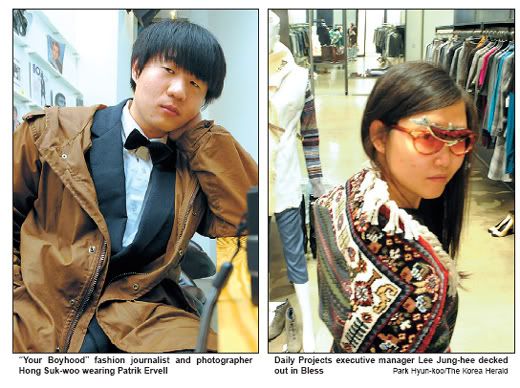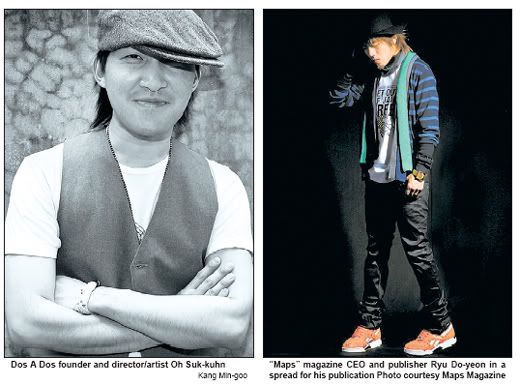Hipsters: trend or just a fad?
Okay, this is just a repost of an article by Jean Oh from the Korea Herald's Culture section.
This is a good article about the growing pop culture and fashion scene here in Seoul. What's funny is I'm seeing a lot of familiar faces in the pics. Yep, it's time to leave Seoul ;)
Sphere: Related ContentHipsters: trend or just a fad?
Type in the word "hipster" and Naver's dictionary spits out the definition: "a person in the know, a well-informed person, a follower of fads." Then follows it up with a couple of alternatives: "jazz performer, jazz aficionado."Hard to say that Naver has hit the nail on the head, but the appearance of "hipster" on this popular Korean internet portal site hints at something that becomes more obvious when you hit the streets of Seoul.
In small but growing numbers, trademark skinny jeans, Converses and vintage flannels pop out from the crowds. Add to that the recent introduction of "NYLON Korea" and "Dazed and Confused Korea" to the domestic magazine market, and it gives rise to the question: Are there hipsters in Korea?
Before delving into the current status of this nation's youth culture, the term "hipster" requires clarification. Taking its roots from the 1940s, when it initially referred to jazz enthusiasts, the word "hipster" is believed to come from a derivative of "hop," slang for opium.
Now, it serves as a somewhat ambiguous catchphrase used to describe the young and the hip. Today's hipster is into things that are cool, new and not mainstream.
In the recent past, cool meant fixed-gear bikes, skinny jeans, Converses, vintage flannel and the so-called "international hipster bible" Vice magazine. Whether any of this still holds true remains to be seen and proven.
Hipsters have been ridiculed and criticized for their lack of identity. They have also been upheld as trendy young people who do not deserve the bad rap the media sometimes gives them.
Good or bad, it looks like the legions of hipsters are growing, spreading through the internet and through the global proliferation of reportedly hipster-friendly brands like American Apparel, UNIQLO and Converse.
Has it reached Seoul?
Dos A Dos art director Kim Young-bin at the 7th Dos A Dos Party[youweresleeping.com]
Dos A Dos
"I am not a hipster," says Dos A Dos founder and director/artist Oh Suk-kuhn.
Dressed from head to toe in vintage, including his 1,000 won cardigan, Oh is the force behind Dos A Dos, a party known for attracting an exciting and unusually dressed crowd - think swimsuits and guys wearing dresses.
And he does not seem to be too fond of hipsters.
"I don't like hipsters," artist Oh states firmly. "I'm too creative to be a hipster."
When asked if they come to his party, he answers, "Of course, lots of hipsters come. When we first started out, it was a sort of meeting of music aficionados and fashionable people. And then hipsters flowed in and I am not too crazy about it."
What about "real" hipsters? Oh pauses: "A real hipster is someone who has their own distinct and clear-cut color."
Oh is quick to separate himself and his Dos A Dos members from the crowd.
"I do not think that we are like those current New York hipsters who follow that which is hip, thoughtlessly," he elaborated.
It is hard to know what group Oh is a part of. A staunch devotee of vintage, "I can't wear new clothes," he explains, Oh was once a middle school kid who went to rock concerts and watched guys head bang to death metal. By the time he entered high school, Oh was donning skinny jeans.
And after spending about three years in England studying photography, he came back home to find, to his disappointment, that no one was listening to electro music.
"I was so frustrated that I started a party in a small space with a Korean friend from London," he said. "The first sort of official Dos A Dos party was in September 2006."
To his surprise, it drew a good crowd. From there on out, he and his members held seven more. The last Dos A Dos was in October.
But what initially started out as a fashionable and artistic gathering of the like-minded grew into a party that drew 400 to 500.
The 29-year-old founder is not too thrilled about the overwhelming turnout, citing a change in partygoers, a theft and issues with the current venue as obstacles to his vision of Dos A Dos.
Whether or not he means hipsters when he says, "people came with a different attitude," is unclear. But Oh believes that hipsters are here to stay.
"I think hipsters will continue to appear."
Nylon, Dazed and Maps
According to Oh, the publication of domestic versions of magazines like Dazed and Nylon came as no surprise.
"They knew that it was time," he said. "A lot of things had already shown up. Street brand mags, (multicultural space) Daily Projects and Dos A Dos. So, of course, Nylon and Dazed came."
The original London-based Dazed and Confused and the U.S.-based NYLON have made a name for themselves for their unique approach to fashion, art and music. And now they have entered the Korean market.
Dazed and Confused Korea kicked off with its May issue and NYLON Korea with its September issue this year.
"Magazines like Nylon and Dazed don't show the trends of the masses," said Nylon Korea editor-in-chief Ketherine Koo. "It is for those who want to create their own style. They want something new all the time."
"We want to make a magazine for real hipsters," explained editor Koo. "But it is a mass market ... We hope that hipsters, at this point a minority, will lead the culture of the masses and that we will be, in turn, a medium that appeals to them."
The 38-year-old editor-in-chief maintained a positive outlook on the future of Korean hipsters.
"Right now, I think there a lot of young people with a hipster mindset and that they are increasing in great numbers," said Koo.
Dazed and Confused Korea editor-in-chief Annie Kim adopted a more conservative stance.
"Aren't they just one part of society?" Kim asked. "Like two or three, three or four out of 10? I think it may be exaggerated."
"There are hipsters though," the 33-year-old editor-in-chief continued. "It definitely seems to have increased. Kids who have just graduated, university students and contributing editors and people I meet seem to have that disposition."
When asked if Dazed and Confused Korea was a hipster magazine, Kim answered: "There is that inclination, but if you mean 'hipster' as in 'street-based subculture,' then we may have hipster-like elements but our magazine is upscale."
Yet, oddly enough, there is no official term for this group of Korean hipsters.
"No, there are no terms for trendy kids in Korea," said Kim.
Ryu Do-yeon, CEO and publisher of "maps" magazine, suggested "skinny tribe" and "BigBang style" as potential catchphrases for those who wear skinny jeans or subscribe to the flair of the hit Korean boy band.
Ryu, who first started out with an online magazine when he was 18, has now been heading his own domestic fashion rag for about two years now.
The 24-year-old publisher covers obscure musicians and artists, targeting "stylish people in their 20s, to help them dress up more."
In addition to artistic layouts, "maps" sports a hefty set of street shots featuring hip Koreans decked out in animal print skinny jeans, stylishly assembled blends of American Apparel and Comme des Garcons and, of course, vintage.
"I wanted to show Korean style to Koreans and to those overseas," said Ryu of his street section.
When asked if he thinks his magazine caters to hipsters, he answered: "You can say that it does. And you can say that it doesn't."
A collage of Dos A Dos party-goers and DJs[Kang Min-goo] Daily Projects and Your Boyhood
According to publisher Ryu, fashion-forward people are the rise, and the boom in select shops serves as a result of the desire for "something new."
Among the slew of select shops that have hit Seoul, Cheongdam-dong's Daily Projects emerges as a pioneer in the world of fashion, due in part, to its executive manager Lee Jung-hee.
Educated at Parsons, Lee masterminded the Daily Projects' event that was part of Seoul Fashion Week's Generation Next, causing a stir in October. Her high profile participants included prominent fashion expert, Diane Pernet, who screened "A Shaded View on Fashion Film" in Korea for the first time, and Danish designer Henrik Vibskov, who presented during fashion week.
"I invited him (Vibskov) here," said Lee. "I went to Denmark to meet him. I was like, 'Yo, do you want to come?'"
Lee's multicultural space, complete with a cafe where one can pore for hours over a serious collection of reading materials - including the U.K.'s "Dazed and Confused," "i-D," and "Monocle" - and two floors worth of hip brands like Band of Outsiders and Bless, also showcases art.
"For some reason, we attract the younger public," said the 34-year-old executive manager.
When asked if she thinks the hipster trend has hit Korea, Lee answered: "Yeah, definitely. They are fashion masters."
"Young kids, like Japanese kids, starve themselves to buy something," she said. "I see that here too. (They) use all their cash on clothes and eat ramen."
Fashion journalist and photographer Hong Suk-woo, who previously worked as a buyer for Daily Projects, agrees that trendy items like fixed-gear bikes have been infiltrating Korea.
"Yes, there is a bike trend here," said Hong, 25, who runs his own fashion blog, "Your Boyhood" (www.yourboyhood.com). "I thought that was new. Is this not just a trend? Is it a culture? I still haven't sorted it out. There are a few fixed rider crews though."
"I think it might have lasting power," he said.
Hong, whose blog is currently posted as a link on "Face Hunter" (facehunter.blogspot.com), agrees that it looks like the hipster movement in Korea is influenced by globalization.
"Just looking at people's clothes, it seems similar," he said. "But it is where it originates from that matters."
"Korea is good at receiving trends," he continued. "However, now, clubs, DJs and bands are holding experimental performances. That seems to be different from what was happening two or three years ago."
"The year 2008 could be a turning point," said Hong. "Corso Como, Nylon, Dazed have come in."
Add to that the presence of American Apparel, UNIQLO and Converse, and it looks like some form of hipsterdom has entered Korea.
Details
Dos A Dos founder and director-cum-artist Oh Suk-kuhn is currently showing his works at the National Museum of Contemporary Art in Gwacheon as part of the "2008 I AM AN ARTIST" exhibition. For more information call (02) 2188-6000 or visit www.moca.go.kr
For more information on Dos A Dos go to www.Dosados.co.kr
Check out Hong Suk-woo's blog at www.yourboyhood.com, "maps" at www.themaps.co.kr, Dazed and Confused Korea at www.dazeddigital.co.kr and NYLON Korea at www.nylonmedia.co.kr
Daily Projects is located in Cheongdam-dong. Select shop opening hours are from 11:30 a.m. to 8 p.m. daily. The cafe is open from 8 a.m. to 11 p.m. daily. For more information go to dailyprojects.kr or call (02) 3218-4072, -4075.















Haha I am glad to see someone else post that article. I recently arrived in Korea a little over a month ago and I am surprised at the amount of hipsters I've seen here. I am used to all of the hipsters from the Wicker Park part of Chicago, and now they are here in Korea.
ReplyDeleteI guess there is no escaping them, but it does give me a little taste of home :)
I think every major city has them. The thing is, for people who don't know much about Seoul, they think people are still pretty backwards. It's not. It's a pretty darn progressive city and the hipster scene is matching that.
ReplyDeletePlus, sometimes it's fun. I just never had much of a taste for it back home, so I only hang out in that scene maybe once or twice a year. That means I'm definitely not a hipster ;)